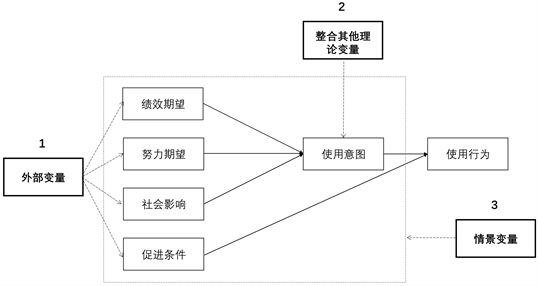1. 引言
近年来,移动设备和无线技术的发展使得创新学习方式成为可能 [1] [2]。学习开始由传统的单向的、面对面传授式学习逐渐发展为依靠移动设备开展的双向交互式学习,即移动学习。移动学习被定义为学习者以互联网技术为中介,以移动设备为载体,不受时间、空间限制而开展的能与教育者进行双向交流的学习活动 [3]。它可以为学习者和教育者提供许多优势,如提高学习的灵活性、增加学习的趣味性 [4]、实现对移动设备的最大化应用等 [5]。
在研究移动学习的相关文献中,整合性信息技术接受模型(the Unified Theory of Acceptance and Use of Technology, UTAUT)因其对用户进行移动学习成效的解释度高等而被众多学者采用 [6]。然而,UTAUT模型在解释某些特定研究情景时用处有限,如在使用平板电脑进行学习的情境下缺乏对于享乐动机变量的探讨 [7]。于是,大部分学者选择在UTAUT模型中加入其他变量以提高该模型的解释力。不过,现有研究缺少对于这些新加入UTAUT模型的变量全面的归类与分析。因此,本文将以2017至2021年2月份发表的相关文献为例,对这些变量进行系统性分析,从而填补现有研究的空白,进一步帮助我们了解UTAUT模型在移动学习中的研究趋势。本文由五个部分构成,下一节将描述文献来源的具体步骤,紧接着对移动学习和UTAUT理论进行基本介绍,随后是对所检索文献的中UTAUT拓展变量的分析与整理,最后在第五节时指出本研究的意义,并探讨现有研究的局限性及未来研究方向。
2. 文献来源
为了对当前基于使用UTAUT模型的移动学习进行多角度分析,本文通过Web of Science数据库进行了广泛的文献搜索。首先,本文在搜索时采用的关键词为“UTAUT” and “Mobile Learning”,搜索范围为2017年至2021年2月份。通过以上两项条件,我们共搜索出了73篇文献。紧接着,我们根据以下几项纳入和排除标准对文献进行了多重筛选:出版年份应在2017年至2021年间;只考虑用英文撰写的文献,只考虑在学术期刊上发表的文献,文献应同时包括UTAUT模型和移动学习。最终共有42篇文献符合纳入标准,因此它们将被当作本文研究的核心。表1具体说明了文献筛选时遵循的纳入和排除标准。

Table 1. Inclusion and exclusion criteria for mobile learning and UTAUT studies
表1. 关于UTAUT和移动学习文献的纳入和排除标准
3. 移动学习及UTAUT概述
3.1. 移动学习
随着互联网时代的发展,移动学习已经成为教育领域的重要趋势之一 [8] [9]。移动学习是指学习者以互联网技术为中介,以移动设备为载体,不受时间、空间限制而开展的能与教育者进行双向交流的学习活动。移动学习在时间和地点上具有较强的灵活性和可获得性。因此,移动学习也被认为是学习方式的未来 [10] [11] [12] [13]。
3.2. UTAUT模型
与传统以教师为中心的学习方式相比,移动学习的出现为教育者和学生提供了一种崭新模式 [3]。对于用户而言,移动学习本质上就是一种新技术的接受与采用。用户对新技术的接受意愿在很大程度上决定了移动学习推广成功的程度,因此一系列的模型被开发出来,以寻求对用户采用新技术的更好的解释。在这些模型中,最受到学者欢迎的是技术接受模型(Technology Acceptance Model, TAM)和整合型信息技术接受模型(Unified Theory of Acceptance and Use of Technology, UTAUT) [14]。UTAUT能够成功解释用户使用技术意图约70%的差异,相较于以往的模型更有说服力 [6]。因此,本文将以UTAUT为理论基础,探讨移动学习的采用。
UTAUT是Venkatesh等学者在2003年建立的由8个理论整合而成的一个模型 [6]。该模型认为绩效期望、努力期望、社会影响和便利条件是用户意图或行为的直接决定因素。下文将对这四个因素进行具体描述。
1) 绩效期望
指的是个人认为使用某项技术/系统能够为其带去收益以及提高学习或工作绩效的程度 [6] [10]。它可以被理解为TAM模型中的感知有用性、动机模型(Motivation Model, MM)中的外在动机及创新扩散理论(Innovation Diffusion Theory, IDT)中的相对优势。在移动学习情景下,绩效期望体现为使用该技术对于改进学生的学习成绩、增加学习机会和生产力的程度 [15]。
2) 努力期望
被定义为用户认为使用某项技术/系统的轻松程度 [10] [16]。努力期望与感知易用性、复杂度和易用性具有相似含义。Chavoshi等学者在研究中验证了努力期望对于移动学习采用意图的显著影响 [17],然而Hoi得出了与之相反的结论 [18]。同时,Venkatesh等学者指出,随着时间的推移,努力期望对于使用新技术意图的影响将逐渐减弱 [6]。其原因可能是用户已经习惯并且接受了使用该技术的方法,从而导致使用难度的减小。
3) 社会影响
代表个人认为对他重要的人或群体认为他应该使用新技术的程度 [10] [16] [19] [20]。在移动学习中,社会影响被认为是影响学生学习意图或行为重要的利益相关者,如家长、老师、校长和同学等 [15]。
4) 便利条件
解释了个人相信在组织和技术设施上能为其使用系统提供的支持程度,或个人对于使用系统所需要的资源的认知 [6] [15]。Naveed等学者指出,便利条件可以被认为是拥有可以进行移动学习的资源,享受得到移动学习所需的设备和设施 [20],如平板电脑、便携式笔记本等。
4. 文献分析
4.1. 根据出版年份进行分类
表2按出版年份汇总了所综述的42篇文献。2018年的文献数量相较于2017年出现了减少,但在2019年出现了大幅度增加,随后在2020年也保持增加(12篇)。据统计,2019至2020年间发表的文献数量(共23篇)在近五年中占比高达55%。文献数量在2019~2020年的快速增长可以总结为以下两点原因:首先,随着互联网技术的发展,移动学习已经日益成为个体、组织所倾向的一种学习形式。其次,国内外学者对于该主题研究的兴趣也不断增加,致力于探讨其在不同领域、不同学科间的发展 [21]。然而,2021年发表的文献数量仅为7篇。造成此现象的理由可能是本研究限定了搜索范围。由于本文将范围限制在2017至2021年2月份,这在一定程度上忽略了2021年3月份起发布的文章,从而导致2021年的文献数量整体偏少。
4.2. 根据期刊进行分类
为了进一步了解当前国内外基于UTAUT模型的移动学习研究期刊分布情况,本文将2017~2021年发表的有关该主题的期刊(两篇及以上)进行了分类,同时指明了中国学者发表文献的数量(如表3)。在调查的近五年内,发表相关文献最多的是《Education And Information Technologies》(共8篇,占19%),紧接着是《Sustainability》、《Journal Of Information Technology Education-research》、《Interactive Learning Environments》和《IEEE Access》(各2篇,占19%)。此外,中国学者发表文献数量为4篇,占总文献篇数的8%左右。在这4篇文献里,有2篇在探讨研究移动学习采用的意愿,另外2篇则和学习管理系统相关。由此可以看出,中国学者在近五年内对于该领域的关注度偏低。
4.3. 根据教育情景进行分类
移动学习已被广泛运用于教育行业中。为进一步了解文献研究所处的教育情景,本文将其分为初等教育、中等教育、高等教育、混合教育情景、以及无明确教育情景五类。由表4可以看出,基于UTAUT的移动学习研究情景集中于高等教育阶段(共33篇,占79%);然后是无特定教育情景(共4篇,占10%),如研究员工和成年人接受移动学习的意愿;紧接着是混合教育情景(共3篇,占7%),如研究英语非母语专业的学生及发展中国家的学生;最后是初等教育阶段(共1篇,占2%)和中等教育阶段(共1篇,占2%)。结果说明,基于UTAUT的移动学习情景主要集中于高等教育阶段,这也印证了Wu等学者的观点 [22]。造成此结果的原因可能是:① 大学的教育设施较为完善,具备使用移动学习的条件。② 大学生学习的自主性较大,便于进行移动学习调查。
4.4. 根据研究方法进行分类
如表5所示,以研究方法作为分类标准时,42篇文献被分为两类:问卷调查法和混合方法。问卷调查法共被35篇文献采用,占比达83%,因此被认为是最受欢迎的研究方法。这与先前学者发现的“问卷调查是收集信息的主流方法”保持了一致 [21] [22]。此结果得益于问卷调查法的覆盖度大、时效性高等特点。其余7篇文献则采用了混合方法进行研究(如问卷调查和访谈)。通过定性与定量的结合,在一定程度上有利于提高研究结果的可靠性。

Table 2. The distribution of mobile learning based on UTAUT literature from 2017 to 2021
表2. 2017年至2021年移动学习(基于UTAUT)相关文献分布

Table 3. The amount of publications related to mobile learning in each journal from 2017 to 2021 (two or more)
表3. 2017年至2021年各期刊发表移动学习相关文献数量(两篇及以上)

Table 4. The distribution of mobile learning based on educational settings from 2017 to 2021
表4. 2017年至2021年移动学习教育情景分布

Table 5. The distribution of mobile learning based on research methods from 2017 to 2021
表5. 2017年至2021年移动学习研究方法分布
4.5. 根据变量类型进行分类
为了对所筛选文献形成更加全面的认识,本文参考Al-Emran对于TAM模型的修改(如图1),将每篇文献新加入UTAUT模型的变量分为了三类:外部变量、整合其他理论变量以及情景变量 [23]。如表6所示,11% (N = 11)的变量是通过外部变量拓展所得,81% (N = 78)的变量由其他理论引入,情景变量则占据剩下的8% (N = 8)。

Figure 1. The classification of variables in UTAUT model
图1. UTAUT模型的变量分类
4.5.1. 外部变量
外部变量指的是用来预测UTAUT模型中四个主要成分的变量,即预测“绩效期望”、“努力期望”、“社会影响”和“促进条件”的变量。相比于其他两种变量分类,引入外部变量的分类数量居于中间。表7按出现次数汇总了这些外部变量。努力期望、用户自主性、促进条件和相对可用性分别被2篇文献所引入。用户自主性和相对可用性被认为是影响员工使用移动技术进行知识转移最显著的因素,这意味着员工期望在使用移动技术进行知识转移的过程中享有充分的自主权,并渴望该技术至少具备与传统设备相同的功能 [24]。Kuciapski在2019年时通过引入工作岗位类型作为调节变量,进一步探讨其如何影响员工进行移动学习的采用 [25]。除此之外,Fagan将享乐动机作为外部变量引入模型中,验证了其在高等教育情景下对于学生使用平板电脑进行学习的绩效期望和努力期望的显著影响 [7]。
4.5.2. 整合其他理论变量
整合其他理论变量即除了UTAUT原始变量外,还引入了来自其他理论的变量对使用意愿进行预测。整合其他理论的变量共有78个,是三种分类中占比最高的变量类型。如表8所示,基于UTAUT模型下的移动学习探究中,大多数学者选择整合来自其他理论的变量以增强UTAUT模型的解释力。这些被整合的变量大多由信息系统理论改编而来。这些理论包括“信息系统成功模型(DeLone and McLean information system success model, DL&ML) [26] [27] ”“技术接受模型(TAM) [17] [28] [29] [30] ”、“期望确认模型(Expectation-confirmation model, ECM) [31] [32] ”和“创新扩散理论(Innovation Diffusion Theory, IDT) [33] ”等。即使众多学者认为UTAUT具有较好的解释力,但模型中缺少“态度”这一重要预测指标也引起了广泛讨论。举例来说,Isaias验证了移动学习型论坛中的同理心态度对使用该论坛的行为意图具有显著影响的假设 [34]。
4.5.3. 情景变量
情景变量被认为是通过引入新的调节变量来对特定情境进行更好的解释。表9按出现次数汇总了这些调节变量。举例来说,Kuciapski通过UTAUT拓展模型验证了工作岗位类型对相对可用性和社会影响与员工使用移动学习的意图的关系的调节作用是正向的 [25]。Aliano引入知识领域和学位年限作为调节变量,分析了大学范围内的移动学习情况。结果表明,知识领域随着年龄的增长会对与绩效期望和社会影响等自变量与使用意图的关系产生正向的调节作用,而学位年限对于促进条件与使用意图的关系则具有负向调节作用:学位越低时,使用意图将越强烈 [35]。Al-Adwan等学者从霍夫斯泰德文化五维度理论中选取不确定性规避作为调节变量,以评估影响学生使用移动学习意图的因素。结果发现,在感知易用性、系统功能及预期信任与移动学习使用意向的关系中,不确定性规避对这三者皆存在负向调节作用 [8]。

Table 6. The distribution of mobile learning variable types from 2017 to 2021
表6. 2017年至2021年移动学习变量类型数量分布

Table 7. The distribution of mobile learning based on external variables from 2017 to 2021
表7. 2017年至2021年移动学习采用外部变量数量分布

Table 8. The distribution of mobile learning based on variables from other theories from 2017 to 2021 (two or more)
表8. 2017年至2021年移动学习整合其他理论变量数量分布(两次及以上)

Table 9. The distribution of mobile learning based on contextual variables from 2017 to 2021
表9. 2017年至2021年移动学习情景变量数量分布
5. 结论
5.1. 讨论
尽管以往的综述为移动学习发展趋势提供了指引,但都忽略了从多个角度对基于UTAUT模型的移动学习的探究。因此,本文通过出版年份、期刊、教育情景、研究方法和变量类型的分类,对近五年来发表的42篇基于UTAUT模型的移动学习采用文献进行分析,并得出了如下一些结论。
首先,基于UTAUT模型下的移动学习文献中,绝大部分都通过整合其他理论变量对原模型进行拓展,其次则是通过引入外部变量,添加情景变量的情况最少。其次,问卷调查法被认为是在该主题研究下最受欢迎的方法,83%的文献都选取了该方法进行调查。与此同时,高等教育也因其自身特点成为了移动学习研究的热门情景,紧接着是无特定教育情景和混合教育情景。此外,基于该主题的研究数量在2019至2020年间出现了快速增长。根据截止到2021年2月份的数据统计(共7篇)来看,我们预测研究数量在2021年有望突破2020年(共12篇)。
5.2. 局限性及未来展望
经过上述文献分析,我们得以从五个维度的分类标准对基于UTAUT模型下的移动学习有了更加全面的了解。尽管这些整理结果为后续研究提供了宝贵见解,但仍存在一定的局限性。
1) 现有文献中关于移动学习(mobile learning)、远程学习(distance learning)和电子学习(e-learning)的区分较为模糊。首先,本文在关键词检索时没有包含远程学习和电子学习,可能导致部分文章未被纳入。此外,在所筛选出来的文献中,有些并未明确对这三者学习的关系进行区分,容易让读者产生混淆。未来关于移动学习的研究中,应加入三者的简单对比或直接探讨三者的关系,使读者对于移动学习的范围及定义能有更深刻的理解。
2) 本研究仅通过Web of Science数据库进行了文献检索。建议未来关于移动学习的研究可以从多个数据库中进行检索,如Emerald和Science Direct,以增加研究的广度和深度。
3) 大部分研究都采用横截面数据,仅关注到了移动学习采用意向在一个时点上的情况。由于移动学习会随着时间等因素发生改变,所以横截面数据在一定程度上不能很好地概括全貌。因此,本文建议未来关于移动学习的研究应选取一个较长的时间段进行纵向研究,以更好解释变量之间的因果关系 [7]。
4) 大部分文献的研究方法为问卷调查法。尽管问卷调查法因其覆盖度广、分发方便等优势被众多学者所认可,但问卷本身也具有一定局限性,如样本代表性、样本大小及主观性等。因此,未来研究应当更多地采用混合方法进行研究,通过定性和定量法的结合,以更好地解释移动学习采用度。
5) 在基于UTAUT模型的移动学习研究中,大部分拓展变量都只考虑了UTAUT的正向影响因素。然而,不少学者也验证了学生负向的学习态度对移动学习成效存在显著影响 [36] [37]。因此,未来研究可以考虑引入如焦虑、担忧等对待移动学习的负向感知因素,从而对移动学习展开更加全面的探究。
致谢
本文来自于北京师范大学珠海分校国际商学部励学计划的支持。